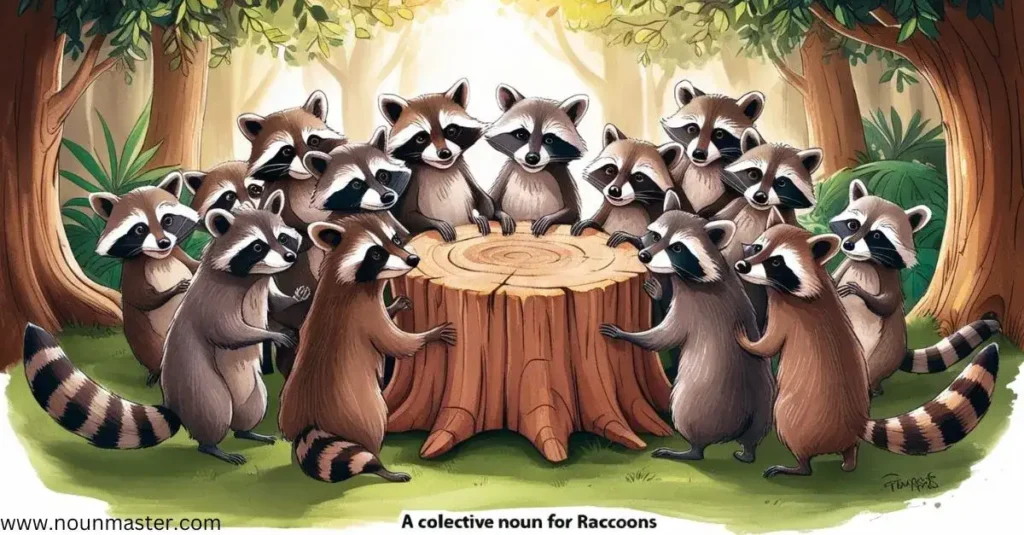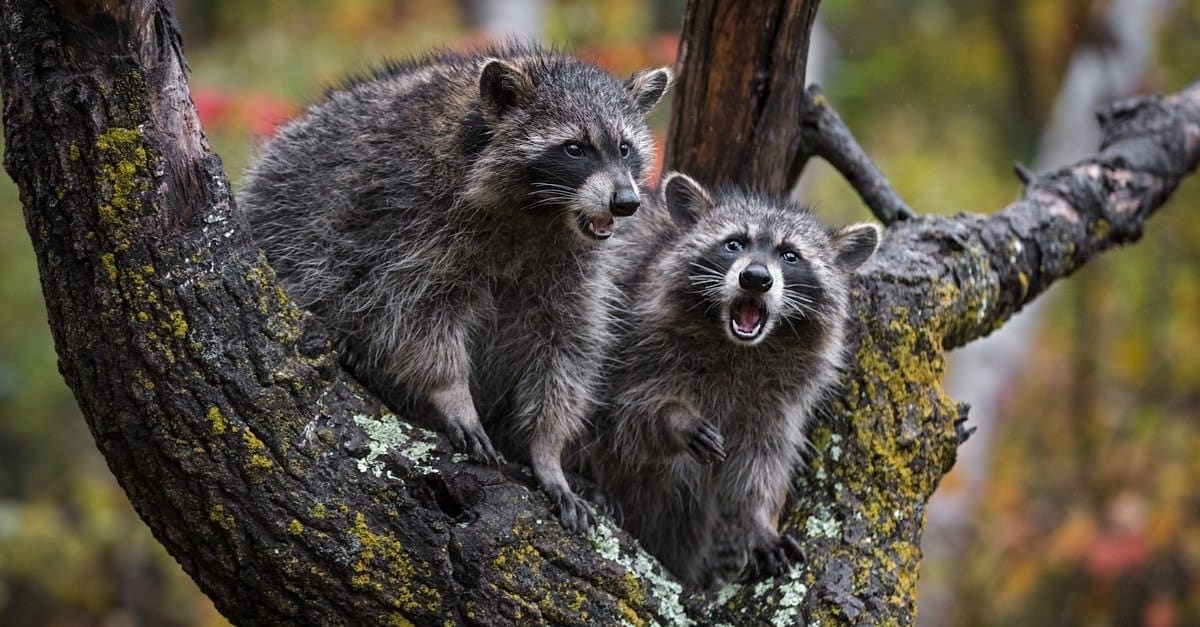A group of raccoons is called a “gaze” or “nursery.” These playful creatures are known for their cleverness and adaptability.
Raccoons are fascinating animals that thrive in various environments. They are social and often seen in groups. Understanding their behavior and social structure can be intriguing. In this blog post, we will explore the unique name for a group of raccoons and delve into their social habits.
You’ll learn why they gather in groups, how they interact, and what makes them such interesting animals. So, let’s dive into the world of raccoons and discover more about these curious creatures and their communal lifestyle.
Overviews of Contents
ToggleIntroduction To Raccoons
Raccoons are small, nocturnal mammals that belong to the Procyonidae family. Known for their distinctive black masks and bushy, ringed tails, these creatures are both fascinating and mischievous. But what is a group of raccoons called? Let’s dive into their characteristics, habitat, and behavior to find out more about these intriguing animals.
Raccoon Characteristics
Raccoons are easily recognizable by their unique features:
- Size: Typically, they weigh between 11 to 23 pounds.
- Coat: Dense fur that is usually grayish-brown.
- Mask: A distinctive black mask around their eyes.
- Tail: Bushy with black and white rings.
- Paws: Dexterous and similar to human hands, perfect for grasping.
Need to understand more about Great Deals? This post might help you. Why Do Raccoons Wash Their Food?: Unveiling the Curious Habit
Habitat And Behavior
Raccoons are highly adaptable and can thrive in various environments:
- Natural Habitat: Forests, wetlands, and urban areas.
- Diet: Omnivorous, feeding on fruits, nuts, insects, and small animals.
- Behavior: Nocturnal and solitary, but sometimes seen in groups.
Raccoons are also known for their cleverness and problem-solving skills. They often raid trash cans in urban areas, searching for food.
Raccoon Social Structure
Raccoons are fascinating creatures. Their social behavior is unique and intriguing. Understanding their social structure can help us appreciate these nocturnal animals better.
Solitary Or Social?
Raccoons are generally solitary animals. They prefer to roam alone, especially males. Female raccoons, however, show more social tendencies.
Mother raccoons often stay with their young until they are old enough to fend for themselves. During this time, they form small family groups.
Typical Group Sizes
The size of a raccoon group, also known as a gaze or a nursery, can vary. On average, a family group consists of a mother and her kits.
Here is a simple breakdown of typical group sizes:
- Solitary Male: 1
- Female with Kits: 2-5
- Winter Dens: Up to 20
During winter, raccoons may share dens. This is not a social behavior but a survival tactic.
| Group Type | Number of Raccoons |
|---|---|
| Solitary Male | 1 |
| Female with Kits | 2-5 |
| Winter Den | Up to 20 |
Raccoons are adaptable. Their social structure changes with their needs and environment.
Find out more about Great Deals by exploring this related topic. How to Keep Raccoons Away: Effective Tips and Tricks
Terminology For Animal Groups
Understanding the different names for animal groups can be fascinating. These terms often reflect historical, cultural, or behavioral aspects of the animals. For example, a group of lions is called a pride, reflecting their majestic and social nature. Similarly, a group of raccoons has its own unique term.
Common Group Names
Some animal groups have names that are widely known. For example:
- Pack – Wolves
- Herd – Cows
- Flock – Birds
- School – Fish
- Swarm – Bees
These names are used often and are easy to remember. They help people quickly identify the type of animal group.
Unique Group Names
Some animals have group names that are more unique and less known. For example:
- Gaggle – Geese
- Murder – Crows
- Parliament – Owls
- Crash – Rhinos
- Unkindness – Ravens
A group of raccoons is called a gaze. This term is not as common. It is unique and adds a layer of intrigue to these nocturnal creatures.
Knowing these unique names can make conversations more interesting. They can also help us understand more about the animals’ behavior and characteristics.

Credit: nounmaster.com
The Term For A Group Of Raccoons
Raccoons are fascinating creatures known for their curious nature. But did you know a group of raccoons has a unique name? Many people are unaware of this interesting fact. The term for a group of raccoons is a “gaze” or a “nursery.”
Expand your knowledge about Great Deals with this article. How to Keep Raccoons Out of Your Yard: Proven Strategies
Origins Of The Term
The term “gaze” has an interesting background. It stems from the way raccoons look at things. Their intense stare appears as if they are gazing. This behavior led to the name “gaze” for a group of raccoons.
The term “nursery” also has roots in their behavior. Female raccoons often gather in groups to care for their young. This nurturing behavior inspired the term “nursery.”
Usage In Literature
Authors often use animal group terms to add color to their stories. The term “gaze” appears in various children’s books. It adds a sense of wonder and curiosity.
“Nursery” is also seen in literature focused on wildlife and nature. It highlights the caring nature of raccoons and their social behavior. Both terms enrich the text and engage readers.
Behavior Of Raccoon Groups
Raccoons are curious and intelligent animals. They often form small groups. This group of raccoons is known as a “gaze” or “nursery.” In these groups, raccoons exhibit fascinating behaviors.
These behaviors help them survive and thrive in the wild. Let’s explore how they forage and protect themselves together.
Foraging Together
Raccoons often forage in groups. This increases their chances of finding food. They use their sharp senses to locate meals. They communicate with each other using sounds and body language.
Foraging together also keeps them safe. They can warn each other of danger. This cooperation ensures they have enough to eat.
Need to understand more about Great Deals? This post might help you. Are Raccoons Nocturnal Animals? Unveiling Their Nightlife Secrets
Defensive Strategies
Raccoons have clever defensive strategies. They work together to protect their group. When threatened, they use their sharp claws and teeth.
They can also climb trees to escape danger. Group members alert each other to predators. This teamwork helps them stay safe.
Raccoons also use their environment to hide. They find shelter in trees, burrows, and abandoned buildings. This helps them avoid larger predators.

Credit: www.skedaddlewildlife.com
Myths And Misconceptions
When you think of raccoons, you might imagine them as sneaky, clever animals. But what about a group of raccoons? There are many myths and misconceptions about these nocturnal creatures. Let’s explore some common beliefs and set the record straight.
Common Myths
- Raccoons only travel alone.
- A group of raccoons is called a “banditry.”
- Raccoons are always aggressive in groups.
Many people believe raccoons are solitary animals. They think raccoons only come together during mating season. This is not true. Raccoons can be social, especially females with their young.
Another myth is that a group of raccoons is called a “banditry.” This term might sound fun, but it’s incorrect. The correct term is a “gaze” or “nursery.” These terms reflect their social behavior more accurately.
Finally, some think raccoons are always aggressive in groups. While raccoons can be protective, they are not always hostile. They usually prefer avoiding conflict.
Debunking Misconceptions
Let’s clear up these misconceptions with facts:
| Myth | Fact |
|---|---|
| Raccoons travel alone. | Raccoons can be social, especially mothers and their young. |
| A group is called a “banditry.” | The correct terms are “gaze” or “nursery.” |
| Raccoons are always aggressive in groups. | Raccoons avoid conflict and are not always hostile. |
Understanding these facts helps appreciate raccoons more. They are complex animals with interesting social behaviors. Next time you see raccoons, remember they are not just solitary bandits. They might be part of a gaze or a nursery, working together to survive.
Conservation Status
The conservation status of raccoons is a topic of interest for many. These curious creatures face various threats in their natural habitats. Understanding their conservation status helps us protect them better.
Current Threats
Raccoons face several threats in the wild. Habitat loss is a major issue. Urban development reduces their living spaces. Pollution also affects their food sources and health. Climate change impacts their survival as well. These threats put raccoons at risk and challenge their populations.
Conservation Efforts
Many organizations work to protect raccoons. Conservation programs aim to preserve their habitats. Efforts include creating wildlife reserves. Educating the public about raccoons helps too. Safe disposal of waste reduces food contamination. These actions support raccoon populations and help them thrive.
Fun Facts About Raccoons
Raccoons are fascinating creatures with many interesting traits. They are known for their cleverness and adaptability. This section explores some fun facts about these nocturnal animals.
Interesting Trivia
- Raccoons are often seen washing their food before eating it.
- A group of raccoons is called a gaze or a nursery.
- They have highly sensitive front paws. This helps them find food in the dark.
- Raccoons are excellent climbers and swimmers. They can adapt to various environments.
Cultural References
Raccoons often appear in folklore and popular culture. They are known for their mischievous and clever behavior.
- In Native American lore, raccoons are seen as tricksters. They often outwit others.
- Raccoons appear in many children’s books and cartoons. Rocket Raccoon from Marvel Comics is a popular character.
- In Japan, the tanuki is a mythical raccoon-dog. It is known for its shape-shifting abilities.

Credit: a-z-animals.com
Frequently Asked Questions
What Is A Group Of Raccoons Called?
A group of raccoons is called a nursery or a gaze. This term is used when they are seen together.
Why Is A Raccoon Group Called A Nursery?
The term “nursery” is used because mother raccoons often group together to care for their young collectively.
How Many Raccoons Are In A Nursery?
A nursery of raccoons typically consists of a mother and her offspring. It can also include other females and their kits.
Do Raccoons Live In Groups?
Raccoons are generally solitary animals but may form nurseries during breeding seasons. This is for the care of their young.
Conclusion
A group of raccoons is called a nursery, gaze, or sometimes a mask. These clever creatures often gather for warmth and protection. Understanding their social behavior helps us appreciate their unique nature. Next time you spot raccoons, remember their interesting group dynamics.
It’s fascinating to learn about the different names and habits of animals. Keep exploring the wonders of wildlife to gain more insights. Each fact brings us closer to understanding the natural world better. So, stay curious and enjoy observing raccoons and other creatures around you.




